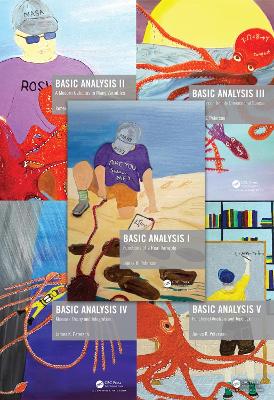Basic Analysis: Volumes I-V is written with the aim of balancing theory and abstraction with clear explanations and arguments, so that students and researchers alike who are from a variety of different areas can follow this text and use it profitably for self-study.
The first volume is designed for students who have completed the usual calculus and ordinary differential equation sequence and a basic course in linear algebra. This is a critical course in the use of abstraction, but is just first volume in a sequence of courses which prepare students to become practicing scientists.
The second volume focuses on differentiation in n-dimensions and important concepts about mappings between finite dimensional Euclidean spaces, such as the inverse and implicit function theorem and change of variable formulae for multidimensional integration. These important topics provide background in important applied and theoretical areas which are no longer covered in mathematical science curricula. Although it follows on from the preceding volume, this is a self-contained book, accessible to undergraduates with a standard course in undergraduate analysis.
The third volume is intended as a first course in abstract linear analysis. This textbook covers metric spaces, normed linear spaces and inner product spaces, along with many other deeper abstract ideas such a completeness, operators and dual spaces. These topics act as an important tool in the development of a mathematically trained scientist.
The fourth volume introduces students to concepts from measure theory and continues their training in the abstract way of looking at the world. This is a most important skill to have when your life's work will involve quantitative modeling to gain insight into the real world. This text generalizes the notion of integration to a very abstract setting in a variety of ways. We generalize the notion of the length of an interval to the measure of a set and learn how to construct the usual ideas from integration using measures. We discuss carefully the many notions of convergence that measure theory provides.
The final volume introduces graduate students in science with concepts from topology and functional analysis, both linear and nonlinear. It is the fifth book in a series designed to train interested readers how to think properly using mathematical abstractions, and how to use the tools of mathematical analysis in applications.
It is important to realize that the most difficult part of applying mathematical reasoning to a new problem domain is choosing the underlying mathematical framework to use on the problem. Once that choice is made, we have many tools we can use to solve the problem. However, a different choice would open up avenues of analysis from a different, perhaps more productive perspective. In this volume, the nature of these critical choices is discussed using applications involving the immune system and cognition.
Features:
- Can be used as a supplementary text for anyone whose work requires that they begin to assimilate more abstract mathematical concepts as part of their professional growth
- Function as a traditional textbook as well as a resource for self-study
- Suitable for mathematics students and for those in other disciplines such as biology, physics, and economics and others requiring a careful and solid grounding in the use of abstraction in problem solving
- Emphasizes learning how to understand the consequences of the underlying assumptions used in building a model
- Regularly uses computation tools to help understand abstract concepts.
- ISBN10 113805514X
- ISBN13 9781138055148
- Publish Date 25 May 2021
- Publish Status Active
- Publish Country GB
- Publisher Taylor & Francis Ltd
- Imprint CRC Press
- Format Hardcover
- Pages 2688
- Language English
